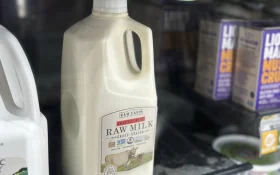Despite years of warnings about the health risks associated with drinking unpasteurized milk, sales of raw milk appear to be on the rise, even in the face of a recent outbreak of bird flu in dairy cows.
Since March 25, when the bird flu virus was first confirmed in U.S. cattle, weekly sales of raw cow’s milk have increased by 21% to 65% compared to the same periods last year, according to market research firm NielsenIQ.
This trend goes against the advice of the Food and Drug Administration (FDA) and the Centers for Disease Control and Prevention (CDC), which consider raw milk one of the “riskiest” foods people can consume.
The CDC warns that raw milk can be contaminated with harmful germs that can cause serious illness.
As of Monday, at least 42 herds in nine states have been confirmed to have cows infected with the type A H5N1 bird flu virus. While the virus has been found in high levels in the raw milk of infected cows, the FDA has stated that pasteurized milk products are safe to consume, as the heat treatment kills the virus.
However, it is not yet known whether live virus can be transmitted to people who drink raw milk.
Despite the risks, raw milk products continue to gain popularity, with some consumers believing that they are healthier and lack additives. Raw milk advocates often express mistrust in government officials and reject expert advice.
From 1998 to 2018, the CDC documented more than 200 illness outbreaks traced to raw milk, which sickened over 2,600 people and hospitalized more than 225. Experts liken drinking raw milk to playing Russian roulette, with the risk of illness increasing with each consumption.
To combat the rising popularity of raw milk, some suggest that the CDC and FDA should use social media to promote the health benefits of pasteurized milk and engage with consumers to understand their motivations for drinking raw milk.
The Associated Press contributed to this article.
